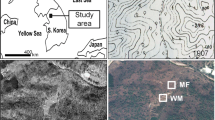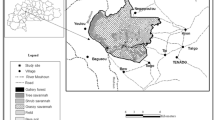Abstract
The demise of coppicing in UK ancient woodlands, combined with the planting of non-native, fast-growing conifers in the twentieth century, heightens the potential recharge value of ground flora seed banks. Soil cores from adjoining semi-natural and conifer-containing stands in four lowland ancient woods in central England were removed to establish seed bank species richness. During a fourteen-month germination trial soil from two depths yielded 6554 seedlings from 81 species, ten of which showed a strong affinity for ancient woodland conditions. Juncus effusus accounted for 80% of emergent seeds whilst 23 other species, including Lysimachia nummularia and Potentilla sterilis, were represented by only one individual. Species richness is described by a model that explains 40% of observed variance (P < 0.00001). The model has three significant variables: species richness increases as soil pH rises, and decreases with both depth and increasing time since the most recent planting/disturbance event. No difference was found in the density of seeds from species common to paired semi-natural and conifer-containing stands that were separated only by a woodland ride, suggesting prior management and environmental conditions have a greater influence on seed banks than current stand type. Sørensen similarity index values revealed poor congruence between above-ground vegetation and species in the seed bank. Taking pH measurements in conifer stands identified as younger in terms of planting/disturbance may help locate areas where greater numbers of species (including woodland specialists) are located. Caution is required, however, as these seed banks may also contain non-target, competitive species that may swamp the regeneration of woodland specialists.


Similar content being viewed by others
Abbreviations
- ASNW:
-
Ancient semi-natural woodlands
- PAWS:
-
Plantations on ancient woodland sites
- AWIS:
-
Ancient woodland indicator species
- GLM:
-
General linear model
References
Augusto L, Dupouey J-L, Picard J-F et al (2001) Potential contribution of the seed bank in coniferous plantations to the restoration of native deciduous forest vegetation. Acta Oecol 22:87–98
Baeten L, Jacquemyn H, Van Calster H et al (2009) Low recruitment across life stages partly accounts for the slow colonisation of forest herbs. J Ecol 97:109–117
Bekker RM, Verweij GL, Smith REN et al (1997) Soil seed banks in European grasslands: does land use affect regeneration perspectives? J Appl Ecol 34:1293–1310
Biodiversity: The UK Steering Group Report (1995) Volume 1: Meeting the Rio Challenge, HMSO
Blamey M, Grey Wilson C (1989) The illustrated flora of Britain and northern Europe. Hodder and Stoughton, London
Blamey M, Fitter R, Fitter A (2003) Wild flowers of Britain and Ireland. A & C Black Publishers Ltd, London
Bossuyt B, Hermy M (2001) Influence of land use history on seed banks in European temperate forest ecosystems: a review. Ecography 24:225–238
Bossuyt B, Honnay O (2008) Can the seed bank be used for ecological restoration? An overview of seed bank characteristics in European communities. J Veg Sci 19:875–884
Bossuyt B, Hermy M, Deckers J (1999) Migration of herbaceous plant species across ancient-recent forest ecotones in central Belgium. J Ecol 87:628–638
Bossuyt B, Heyn M, Hermy M (2002) Seed bank and vegetation composition of forest stands of varying age in central Belgium: consequences for regeneration of ancient forest vegetation. Plant Ecol 162:33–48
Brown AHF, Oosterhuis L (1981) The role of buried seed in coppice woods. Biol Conserv 21:19–38
Bruelheide H, Udelhoven P (2005) Correspondence of the fine-scale spatial variation in soil chemistry and the herb layer vegetation in beech forests. For Ecol Manage 210:205–223
De Keersmaeker L, Martens L, Verheyen K et al (2004) Impact of soil fertility and insolation on diversity of herbaceous woodland species colonizing afforestations in Muizen Forest (Belgium). For Ecol Manage 188:291–304
Decocq G, Valentin B, Toussaint B et al (2004) Soil seed bank composition and diversity in a managed temperate deciduous forest. Biodivers Conserv 13:2485–2509
Devlaeminck R, Bossuyt B, Hermy M (2005) Inflow of seeds through the forest edge: evidence from seed bank and vegetation patterns. Plant Ecol 176:1–17
Dostal P, Breznova M, Kozlickova V et al (2005) Ant-induced soil modification and its effect on plant below-ground biomass. Pedobiologia 49:127–137
Dougall TAG, Dodd JC (1997) A study of species richness and diversity in seed banks and its use for the environmental mitigation of a proposed holiday village development in a coniferized woodland in south east England. Biodivers Conserv 6:1413–1428
Dzwonko Z (2001) Migration of vascular species to a recent wood adjoining ancient woodland. Acta Soc Bot Pol 70:71–77
Dzwonko Z, Loster S (1992) Species richness and seed dispersal to secondary woods in southern Poland. J Biogeogr 19:195–204
EU Council Habitats Directive (1992) The conservation of natural habitats and of wild flora and fauna (92/42/EEC) http://eur-lex.europa.eu/LexUriServ/LexUriServ.do?uri=CELEX:31992L0043:EN:NOT. Accessed 6 Aug 2009
Eycott AE, Watkinson AR, Dolman PM (2006a) Ecological patterns of plant diversity in a plantation forest managed by clearfelling. J Appl Ecol 43:1160–1171
Eycott AE, Watkinson AR, Dolman PM (2006b) The soil seedbank of a lowland conifer forest: the impacts of clear-fell management and implications for heathland restoration. For Ecol Manage 237:280–289
Falinska K (1999) Seed bank dynamics in abandoned meadows during a 20-Year period in the Bialowieza National Park. J Ecol 87:461–475
Forestry Commission (1985a) Management guidelines for broadleaved woodland. Forestry Commission, Edinburgh
Forestry Commission (1985b) The policy for broadleaved woodland. Forestry Commission, Edinburgh
Forestry Commission (2004) The UK Forestry Standard (Revised Edition). http://www.forestry.gov.uk/PDF/fcfc001.pdf/$FILE/fcfc001.pdf. Accessed 15 Aug 2009
Forestry Commission (2005). Keepers of time: a statement of policy for England’s ancient and native woodland http://www.forestry.gov.uk/pdf/anw-policy.pdf/$FILE/anw-policy.pdf. Accessed 15 Aug 2009
Forestry Commission, Northants Forest District, Top Lodge, Fineshade, Nr Corby, Northants, NN17 3BB
Godefroid S, Phartyal SS, Koedam N (2006) Depth distribution and composition of seed banks under different tree layers in a managed temperate forest ecosystem. Acta Oecol 29:283–292
Greatorex-Davies JN, Sparks TH, Hall ML et al (1993) The influence of shade on butterflies in rides of coniferised lowland woods in southern England and implications for conservation management. Biol Conserv 63:31–41
Grime JP (1974) Vegetation classification by reference to strategies. Nature 250:26–31
Grime JP, Hodgson JG, Hunt R (2007) Comparative plant ecology—a functional approach to common British species, 2nd edn. Castlepoint Press, Kirkcudbrightshire
Hermy M, Verheyen K (2007) Legacies of the past in the present-day forest biodiversity: a review of past land-use effects on forest plant species composition and diversity. Ecol Res 22:361–371
Hermy M, Honnay O, Firbank L et al (1999) An ecological comparison between ancient and other forest plant species of Europe, and the implications for forest conservation. Biol Conserv 91:9–22
Hill MO, Stevens PA (1981) The density of viable seed in soils of forest plantations in upland Britain. J Ecol 69:693–709
Jermy AC, Simpson DA, Foley MJY et al (2007) Sedges of the British Isles BSBI Handbook No. 1 (3rd edition). Botanical Society of the British Isles, London
Kipfer T, Bosshard A (2007) Low seed bank of herb species suitable for grazing hampers the establishment of wood pastures in the Swiss lowlands. Bot Helv 117:159–167
Kirby KJ (1988) Changes in the ground flora under plantations on ancient woodland sites. Forestry 61(4):317–338
Kjellsson G (1992) Seed banks in Danish deciduous forests: species composition, seed influx and distribution pattern in soil. Ecography 15:86–100
Lewis J (1973) Longevity of crop and weed seeds after 20 years in soil. Weed Res 13:179–191
MAGIC (2009) Multi-agency geographic information for the countryside—web-based environmental interactive map. http://www.magic.gov.uk/website/magic/. Accessed 15 Aug 2009
Magurran AE (2004) Measuring biological diversity. Blackwell Publishing, Oxford
McCollin D, Jackson JI, Bunce RGH et al (2000) Hedgerows as habitat for woodland plants. J Environ Manage 60:77–90
Natural England (2006) Ancient woodland; Guidance material for local authorities (AWG1) http://naturalengland.etraderstores.com/NaturalEnglandShop/Product.aspx?ProductID=9782c3a2-dcb5-4aca-b36d-5e3d6eff1103. Accessed 9 Aug 2009
Olano JM, Caballero I, Laskurain NA et al (2002) Seed bank spatial pattern in a temperate secondary forest. J Veg Sci 13:775–784
Ordnance Survey (1969) Geological survey of Great Britain (England and Wales): solid and drift Map Sheet 202. Institute of Geological Sciences, Southampton
Ovington (1953) Studies of the development of woodland conditions under different trees. I. Soils pH. J Ecol 41:13–24
Peterken GF (1974) A method for assessing woodland flora for conservation using indicator species. Biol Conserv 6:239–245
Peterken GF (1976) Long-term changes in woodlands of Rockingham forest and other areas. J Ecol 64:123–146
Peterken GF (2001) Ecological effects of introduced tree species in Britain. For Ecol Manage 141:31–42
Pryor SN, Smith S (2002) The area and composition of plantations on ancient woodland sites. The Woodland Trust, Grantham
Pryor SN, Curtis TA, Peterken GF (2002) Restoring plantations on ancient woodland sites. The Woodland Trust. www.woodland-trust.org.uk/policy/publicationsindex.htm. Accessed 21 Aug 2009
Rackham O (1980) Ancient woodland—its history, vegetation and uses in England. Edward Arnold, London
Rackham O (2006) Woodlands. Collins, London
Rees M (1997) Seed dormancy. In: Crawley MJ (ed) Plant ecology. Blackwell Science Ltd, Oxford, pp 214–238
Roovers P, Bossuyt B, Igodt B et al (2006) May seed banks contribute to vegetation restoration on paths in temperate deciduous forest? Plant Ecol 187:25–38
Salisbury EJ (1976) Seed output and the efficacy of dispersal by wind. Proc R Soc Lond B Biol Sci 192:323–329
Spencer JW, Kirby KJ (1992) An inventory of ancient woodland for England and Wales. Biol Conserv 62:77–93
Staaf H (1987) Foliage litter turnover and earthworm populations in three beech forests of contrasting soil and vegetation types. Oecol 72:58–64
Stace C (1997) New flora of the British Isles, 2nd edn. Cambridge University Press, Cambridge
StatSoft Inc. Statistica, Release 8. http://www.statsoft.com/. Accessed 6 Aug 2009
Templeton AR, Levin DA (1979) Evolutionary consequences of seed pools. Am Nat 114:232–249
Thompson K, Bakker J, Bekker R (1997) The soil seed bank of North West Europe; methodology, density and longevity. Cambridge University Press, Cambridge
UNCED (1992) Convention on Biological Diversity, Rio de Janeiro http://www.un.org/documents/ga/conf151/aconf15126-1annex1.htm. Accessed 6 Aug 2009
Warr SJ, Kent M, Thompson K (1994) Seed bank composition and variability in five woodlands in South-West England. J Biogeogr 21:151–168
Willems JH, Huijsmans KGA (1994) Vertical seed dispersal by earthworms: a quantitative approach. Ecography 17:124–130
Wilsden LW (1915) Plumpton. Hand typed document in Northampton Central library (Local History)
Acknowledgments
We would like to thank Cheryl Lundberg and Paul Malcolm of The Forestry Commission for permission to work in the four woods, and for providing information on woodland histories, stand types and ages, Duncan McCollin for his helpful comments during manuscript preparation, and the valuable comments of two anonymous referees that greatly improved the focus of the manuscript. Hilary E. Erenler was partially funded by grants from The Crowther Trust (The Open University) and the T.D. Lewis Fund (The University of Northampton).
Author information
Authors and Affiliations
Corresponding author
Rights and permissions
About this article
Cite this article
Erenler, H.E., Ashton, P.A., Gillman, M.P. et al. Factors determining species richness of soil seed banks in lowland ancient woodlands. Biodivers Conserv 19, 1631–1648 (2010). https://doi.org/10.1007/s10531-010-9793-1
Received:
Accepted:
Published:
Issue Date:
DOI: https://doi.org/10.1007/s10531-010-9793-1




